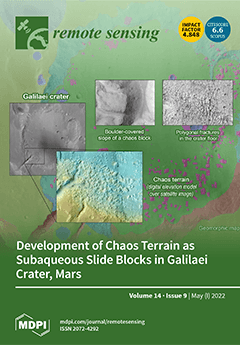To explore rapid anthocyanin (Anth) detection technology based on remote sensing (RS) in tree peony leaves, we considered 30 species of tree peonies located in Shaanxi Province, China. We used an SVC HR~1024i portable ground object spectrometer and mini-unmanned aerial vehicle (UAV)-borne RS
[...] Read more.
To explore rapid anthocyanin (Anth) detection technology based on remote sensing (RS) in tree peony leaves, we considered 30 species of tree peonies located in Shaanxi Province, China. We used an SVC HR~1024i portable ground object spectrometer and mini-unmanned aerial vehicle (UAV)-borne RS systems to obtain hyperspectral (HS) reflectance and images of canopy leaves. First, we performed principal component analysis (PCA), first-order differential (FD), and continuum removal (CR) transformations on the original ground-based spectra; commonly used spectral parameters were implemented to estimate Anth content using multiple stepwise regression (MSR), partial least squares (PLS), back-propagation neural network (BPNN), and random forest (RF) models. The spectral transformation highlighted the characteristics of spectral curves and improved the relationship between spectral reflectance and Anth, and the RF model based on the FD spectrum portrayed the best estimation accuracy (
R2c = 0.91;
R2v = 0.51). Then, the RGB (red-green-blue) gray vegetation index (VI) and the texture parameters were constructed using UAV images, and an Anth estimation model was constructed using UAV parameters. Finally, the UAV image was fused with the ground spectral data, and a multisource RS model of Anth estimation was constructed, based on PCA + UAV, FD + UAV, and CR + UAV, using MSR, PLS, BPNN, and RF methods. The RF model based on FD+UAV portrayed the best modeling and verification effect (
R2c = 0.93;
R2v = 0.76); compared with the FD-RF model,
R2c increased only slightly, but
R2v increased greatly from 0.51 to 0.76, indicating improved modeling and testing accuracy. The optimal spectral transformation for the Anth estimation of tree peony leaves was obtained, and a high-precision Anth multisource RS model was constructed. Our results can be used for the selection of ground-based HS transformation in future plant Anth estimation, and as a theoretical basis for plant growth monitoring based on ground and UAV multisource RS.
Full article





